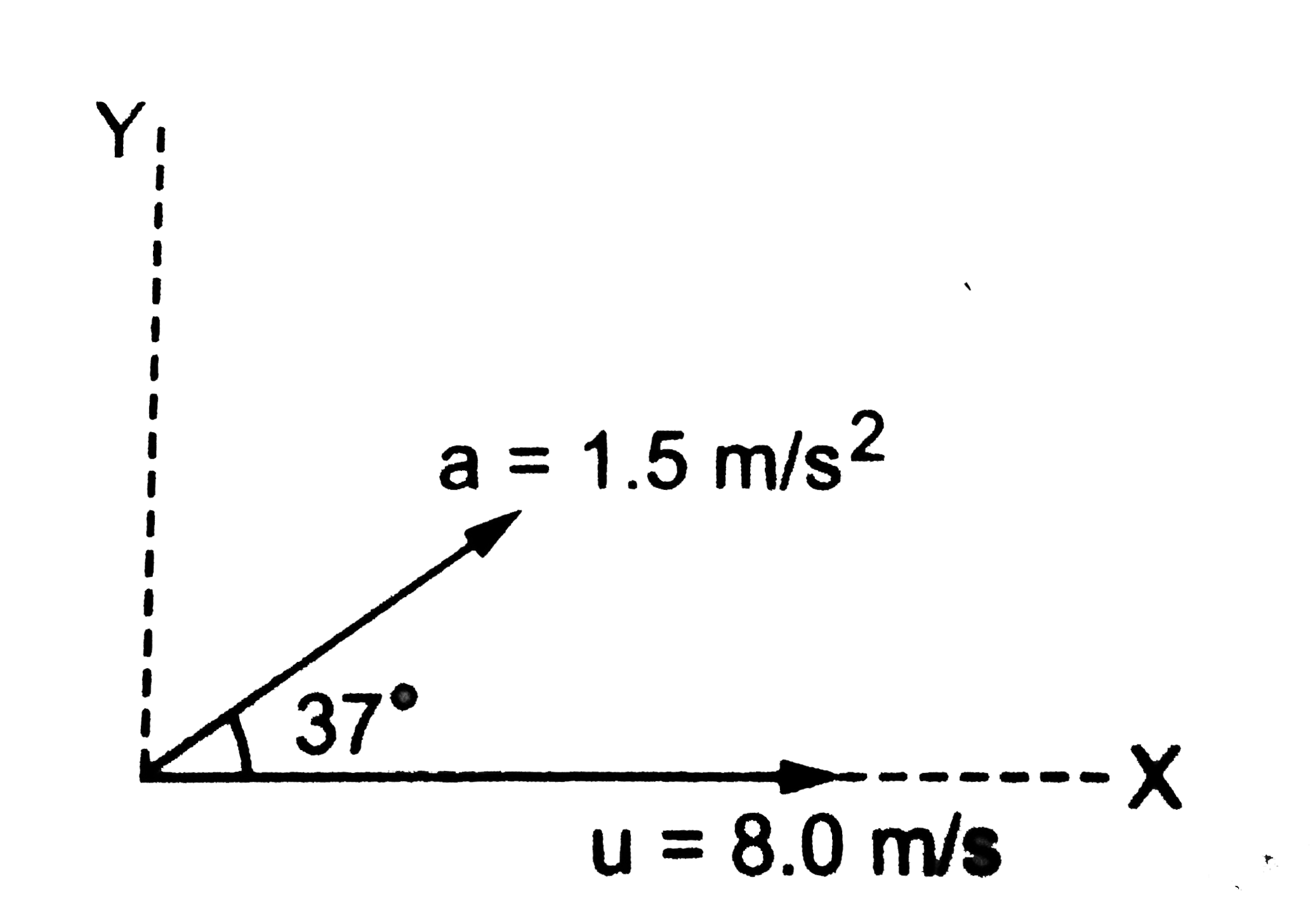Velocity of a particle at time t=0 is 2ˆi m/s. A constant acceleration of 2ms2 acts on the particle for 2s at an angle of 60∘ with its initial velocity. Find the magnitude of velocity and displacement of particle at the end of t=2s.
The correct Answer is:B, C, D
To solve the problem, we will follow these steps:
Step 1: Identify the initial conditions
The initial velocity u of the particle at time t=0 is given as:
u=2^i+0^jm/s
This means the particle has a velocity of 2 m/s in the x-direction and 0 m/s in the y-direction.
Step 2: Determine the acceleration components
The constant acceleration a is given as 2m/s2 at an angle of 60∘ with respect to the initial velocity. We can break this acceleration into its components:
a=ax^i+ay^j
where:
- ax=2cos(60∘)
- ay=2sin(60∘)
Calculating these values:
ax=2⋅12=1m/s2
ay=2⋅√32=√3m/s2
Thus, the acceleration vector is:
a=1^i+√3^jm/s2
Step 3: Calculate the final velocity after 2 seconds
Using the equation of motion:
v=u+at
Substituting the values:
v=(2^i+0^j)+(1^i+√3^j)⋅2
This simplifies to:
v=2^i+0^j+2^i+2√3^j
v=(2+2)^i+(0+2√3)^j=4^i+2√3^jm/s
Step 4: Find the magnitude of the final velocity
The magnitude of the velocity |v| is given by:
|v|=√(4)2+(2√3)2
Calculating this:
|v|=√16+12=√28=2√7m/s
Step 5: Calculate the displacement after 2 seconds
Using the equation of motion for displacement:
s=ut+12at2
Substituting the values:
s=(2^i+0^j)⋅2+12(1^i+√3^j)⋅(22)
This simplifies to:
s=(4^i+0^j)+12(1^i+√3^j)⋅4
s=4^i+0^j+2^i+2√3^j
s=(4+2)^i+(0+2√3)^j=6^i+2√3^jm
Step 6: Find the magnitude of the displacement
The magnitude of the displacement |s| is given by:
|s|=√(6)2+(2√3)2
Calculating this:
|s|=√36+12=√48=4√3m
Final Results
- The magnitude of the final velocity is 2√7m/s.
- The magnitude of the displacement is 4√3m.
The initial velocity u of the particle at time t=0 is given as:
u=2^i+0^jm/s
This means the particle has a velocity of 2 m/s in the x-direction and 0 m/s in the y-direction.
The constant acceleration a is given as 2m/s2 at an angle of 60∘ with respect to the initial velocity. We can break this acceleration into its components:
a=ax^i+ay^j
where:
- ax=2cos(60∘)
- ay=2sin(60∘)
ax=2⋅12=1m/s2
ay=2⋅√32=√3m/s2
Thus, the acceleration vector is:
a=1^i+√3^jm/s2
Using the equation of motion:
v=u+at
Substituting the values:
v=(2^i+0^j)+(1^i+√3^j)⋅2
This simplifies to:
v=2^i+0^j+2^i+2√3^j
v=(2+2)^i+(0+2√3)^j=4^i+2√3^jm/s
The magnitude of the velocity |v| is given by:
|v|=√(4)2+(2√3)2
Calculating this:
|v|=√16+12=√28=2√7m/s
Using the equation of motion for displacement:
s=ut+12at2
Substituting the values:
s=(2^i+0^j)⋅2+12(1^i+√3^j)⋅(22)
This simplifies to:
s=(4^i+0^j)+12(1^i+√3^j)⋅4
s=4^i+0^j+2^i+2√3^j
s=(4+2)^i+(0+2√3)^j=6^i+2√3^jm
The magnitude of the displacement |s| is given by:
|s|=√(6)2+(2√3)2
Calculating this:
|s|=√36+12=√48=4√3m
- The magnitude of the final velocity is 2√7m/s.
- The magnitude of the displacement is 4√3m.
Topper's Solved these Questions
- KINEMATICSBOOK - DC PANDEY ENGLISHCHAPTER - KINEMATICSEXERCISE - Exercise 6.8
5 Videos
- KINEMATICSBOOK - DC PANDEY ENGLISHCHAPTER - KINEMATICSEXERCISE - Exercise 6.9
6 Videos
- KINEMATICSBOOK - DC PANDEY ENGLISHCHAPTER - KINEMATICSEXERCISE - Exercise 6.6
5 Videos
- GRAVITATIONBOOK - DC PANDEY ENGLISHCHAPTER - GRAVITATIONEXERCISE - (C) Chapter Exercises
45 Videos
- KINEMATICS 1BOOK - DC PANDEY ENGLISHCHAPTER - KINEMATICS 1EXERCISE - INTEGER_TYPE
15 Videos
Similar Questions
Velocity of particle at time t=0 is 2ms−1.A constant acceleration of 2ms−2 act on the particle for 1 second at an angle of 60∘ with its initial velocity .Find the magnitude velocity and displacement of the particle at the end of t=1s.
View SolutionA particle of mass 1 kg has a velocity of 2m/s. A constant force of 2N acts on the particle for 1s in a direction perpendicular to its initial velocity. Find the velocity and displacement of the particle at the end of 1 s.
View SolutionVelocity of a particle at any time t is v=(2ˆi+2tˆj)m/s. Find acceleration and displacement of particle at t=1s. Can we apply v=u+at or not?
View SolutionVelocity and acceleration of a particle at time t=0are u=(2ˆi+3ˆj)m/sanda=(4ˆi+3ˆj)m/s2 respectively. Find the velocity and displacement if particle at t=2s.
View SolutionA particle starts from rest and moves with an acceleration of a={2+|t−2|}m/s2 The velocity of the particle at t=4 sec is
View SolutionA particle starts from rest and moves with an acceleration of a={2+|t−2|}m/s2 The velocity of the particle at t=4 sec is
View SolutionVelocity of a particle is given as v=(2t2−3)m/s. The acceleration of particle at t = 3s will be :
View SolutionA particle movesin the X-Y plane with a constasnt acceleration of 1.5ms2 in the direction making an angle of 370 with the X-axis.At t=0 the particle is at the orign and its velocity is 8.0 m/s along the X-axis. Find the velocity and the position of the particle at t=4.0 s.

View SolutionThe velocity of a particle is zero at time t = 2s, then
View SolutionA particle is projected from ground with velocity 40(√2)m/s at 45∘. Find
(a) velocity and
(b) displacement of the particle after 2 s. (g=10m/s2)
View Solution
